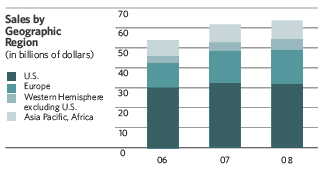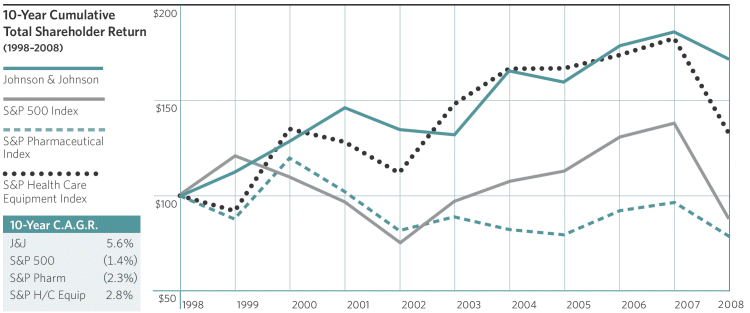A probability of success factor of 75% was used to reflect inherent clinical and regulatory risk and the discount rate applied was 21%.
The IPR&D charge related to the acquisition of ColBar LifeScience Ltd. was $49 million and is associated with the EVOLENCE® family of products, which are biodegradable dermal fillers. The value of the IPR&D was calculated using cash flow projections discounted for the risk inherent in such projects. Probability of success factors ranging from 70 – 80% were used to reflect inherent clinical and regulatory risk and the discount rate applied was 21%.
The IPR&D charge related to the acquisition of Ensure Medical, Inc. was $66 million and is associated with the femoral artery closure device. The value of the IPR&D was calculated using cash flow projections discounted for the risk inherent in such projects. A probability of success factor of 75% was used to reflect inherent clinical and regulatory risk and the discount rate applied was 22%.
With the exception of the Consumer Healthcare business of Pfizer Inc., supplemental pro forma information for 2008, 2007 and 2006 per SFAS No. 141,Business Combinations,and SFAS No. 142,Goodwill and Other Intangible Assets,is not provided, as the impact of the aforementioned acquisitions did not have a material effect on the Company’s results of operations, cash flows or financial position.
With the exception of the divestiture of the Professional Wound Care business of Ethicon, Inc., which resulted in a gain of $536 million before tax, and is recorded in other (income) expense, net, in 2008, divestitures in 2008, 2007 and 2006 did not have a material effect on the Company’s results of operations, cash flows or financial position.
18. Legal Proceedings
PRODUCT LIABILITY
The Company’s subsidiaries are involved in numerous product liability cases in the United States, many of which concern alleged adverse reactions to drugs and medical devices. The damages claimed are substantial, and while the Company is confident of the adequacy of the warnings and instructions for use that accompany such products, it is not feasible to predict the ultimate outcome of litigation. However, the Company believes that if any product liability results from such cases, it will be substantially covered by existing amounts accrued in the Company’s balance sheet and, where available, by third-party product liability insurance.
Multiple products of Johnson & Johnson subsidiaries are subject to numerous product liability claims and lawsuits, including ORTHO EVRA®, RISPERDAL®, DURAGESIC®, CYPHER® Stent and the CHARITÉ™ Artificial Disc. There are approximately 900 claimants who have pending lawsuits or claims regarding injuries allegedly due to ORTHO EVRA®, 507 with respect to RISPERDAL®, 267 with respect to CHARITÉ™, 85 with respect to CYPHER® and 65 with respect to DURAGESIC®. These claimants seek substantial compensatory and, where available, punitive damages.
With respect to RISPERDAL®, the Attorneys General of eight states and the Office of General Counsel of the Commonwealth of Pennsylvania have filed actions seeking reimbursement of Medicaid or other public funds for RISPERDAL® prescriptions written for off-label use, compensation for treating their citizens for alleged adverse reactions to RISPERDAL®, civil fines or penalties, punitive damages, or other relief. The Attorney General of Texas has joined a qui tam action in that state seeking similar relief. Certain of these actions also seek injunctive relief relating to the promotion of RISPERDAL®. The Attorneys General of more than 40 other states have indicated a potential interest in pursuing similar litigation against the Company’s Janssen subsidiary (now Ortho-McNeil-Janssen Pharmaceuticals Inc.) (OMJPI), and have obtained a tolling agreement staying the running of the statute of limitations while they inquire into the issues. In addition, there are six cases filed by union health plans seeking damages for
alleged overpayments for RISPERDAL®, several of which seek certification as class actions. In the case brought by the Attorney General of West Virginia, based on claims for alleged consumer fraud as to DURAGESIC® as well as RISPERDAL®, Janssen was found liable on motion, and damages are likely to be assessed at less than $20 million. Janssen intends to seek to appeal.
Numerous claims and lawsuits in the United States relating to the drug PROPULSID®, withdrawn from general sale by the Company’s Janssen subsidiary in 2000, have been resolved or are currently enrolled in settlement programs with an aggregate cap below $100 million. Litigation concerning PROPULSID® is pending in Canada, where a class action of persons alleging adverse reactions to the drug has been certified.
AFFIRMATIVE STENT PATENT LITIGATION
In patent infringement actions tried in Delaware Federal District Court in late 2000, Cordis Corporation (Cordis), a subsidiary of Johnson & Johnson, obtained verdicts of infringement and patent validity, and damage awards against Boston Scientific Corporation (Boston Scientific) and Medtronic AVE, Inc. (Medtronic) based on a number of Cordis vascular stent patents. In December 2000, the jury in the damage action against Boston Scientific returned a verdict of $324 million and the jury in the Medtronic action returned a verdict of $271 million. The Court of Appeals for the Federal Circuit has upheld liability in these cases, and on September 30, 2008, the district court entered judgments, including interest, in the amounts of $702 million and $521 million against Boston Scientific and Medtronic, respectively. Medtronic paid $472 million in October 2008, representing the judgment, net of amounts exchanged in settlement of a number of other litigations between the companies. The net settlement of $472 million was recorded as a credit to other (income) expense, net in the 2008 consolidated statement of earnings. The $702 million judgment against Boston Scientific is not reflected in the 2008 financial statements as Boston Scientific has appealed the judgments, and no amounts have been received.
Cordis also has two arbitrations against Medtronic seeking royalties for the sale of stent products introduced by Medtronic subsequent to December 2000 pursuant to a 1997 cross-license agreement between Cordis and Medtronic. The hearing on the first of these arbitrations will take place in March 2009.
In January 2003, Cordis filed a patent infringement action against Boston Scientific in Delaware Federal District Court accusing its Express2™, Taxus® and Liberte® stents of infringing the Palmaz patent that expired in November 2005. The Liberte® stent was also accused of infringing Cordis’ Gray patent that expires in 2016. In June 2005, a jury found that the Express2™, Taxus® and Liberte® stents infringed the Palmaz patent and that the Liberte® stent also infringed the Gray patent. Boston Scientific has appealed to the U.S. Court of Appeals for the Federal Circuit.
Cordis has filed several lawsuits in New Jersey Federal District Court against Guidant Corporation (Guidant), Abbott Laboratories, Inc. (Abbott), Boston Scientific and Medtronic alleging that the Xience V™ (Abbott), Promus™ (Boston Scientific) and Endeavor® (Medtronic) drug eluting stents infringe several patents owned by or licensed to Cordis. In October 2008, Cordis filed suit against Boston Scientific in Delaware Federal Court accusing the Taxus Liberte® stent of infringing the Gray patent.
PATENT LITIGATION AGAINST VARIOUS JOHNSON & JOHNSON SUBSIDIARIES
The products of various Johnson & Johnson subsidiaries are the subject of various patent lawsuits, the outcomes of which could potentially adversely affect the ability of those subsidiaries to









